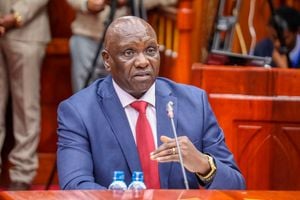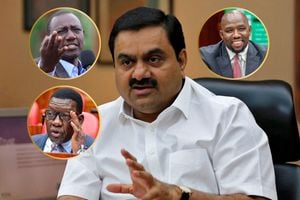Farmer’s switch from maize to sorghum yields big results amid drought

William Chilufya, a Zambian farmer planted drought-resistant crops amid the worst drought in 40 years
What you need to know:
- When Chilufya tilled his land in January in readiness for the planting season, the sky was clear, with no signs of impending rain.
- Yet, he planted and so did other farmers with the hope that the rains would soon follow.
Picture this: It is harvest season but despite investing time, effort, and resources into farming, your fields are barren. Why? The vital rains your crops relied on never arrived. This scenario unfolded during the recent four-year drought, and multiple studies show that many farmers lost their yields because they didn’t adapt on time.
The United Nations Framework Convention on Climate Change (UNFCCC) defines climate adaptation as a way of learning changes in processes, practices and structures to moderate potential damages or to benefit from opportunities associated with climate change. Data published by the Kenya Institute for Public Policy Research and Analysis (KIPPRA) in 2021 shows that there was a decline in maize production from 42.1 million bags in 2020 to 36.7 million bags in 2021—translating to a 12.8 per cent decrease.
Although Kenya is no longer in the grip of drought, one question lingers—what would farmers do if it returns? Currently, many countries in Southern Africa are experiencing drought linked to the El Nino phenomenon, leaving some farmers with reduced to zero harvests. Healthy Nation spoke with William Chilufya, a farmer in Zambia who has adapted to climate change during this dry spell.
When Chilufya tilled his land in January in readiness for the planting season, the sky was clear, with no signs of impending rain. Yet, he planted and so did other farmers with the hope that the rains would soon follow. The parched soil of Zambian farms choked the seeds of farmers who dared to plant. While some seeds survived and sprouted, it was evident that there would be no bumper harvest, if there was to be any at all.
Chilufya was a worried farmer. In normal circumstances, he would have planted maize because it is fast-selling and his country’s staple food. This time, he opted for a different crop. “As a farmer, I began researching crops that could thrive with limited rainfall. After making consultations, I decided to grow either millet or sorghum. I learned that these crops are relatively drought-resistant and can survive even with insufficient rainfall,” he explains.
A decision to plant a crop that would withstand the situation in his country was the easy part, the hurdle came on the next phase of the farming project, which was to get the seeds. “I suffered, I struggled, I made calls to seed companies and I couldn’t find either of the seeds. I walked from one agrovet shop to another in Lusaka town and the only seeds available were maize,” he says.
Through referrals, he eventually found the seeds and purchased a 50-kilogram bag for approximately Sh 6,450. “I, however, planted both maize and sorghum. The rains could come once in three weeks, or once in a month,” says William. He noticed that the maize was struggling to survive, but the sorghum was thriving.
“In the end, I didn’t harvest a single maize cob, despite spending more on fertilisers and pesticides. On the other hand, for sorghum, I only needed to spray against pests, which were coming from the maize crops. Overall, producing sorghum was much cheaper compared to maize,” he explains.
He harvested about three tonnes of sorghum, sold most of it, and saved some to test its viability for planting in the next season. In an update earlier this year, the United Nations Office for the Coordination of Humanitarian Affairs (OCHA) projected that the drought would devastate around 1 million hectares of maize, which represents about half of the country’s total production.
On February 29, Zambian President Hakainde Hichilema declared the drought a national disaster. Eight months on, Zambia is still reeling from the impact of drought—the worst in 40 years. William says the situation is getting worse by the day.
“I am just from a call with a colleague, and she told me that her borehole has totally dried up. It’s not only hers. For those that might still have the water, they are not pumping their tanks to be full,” he says.
William and other farmers in Africa may not attend big climate conferences like the upcoming 29th Conference of Parties (COP29) in Baku, Azerbaijan. However, their stories paint a picture of why Africa urgently needs adaptation finance.
This year has been touted as a climate finance COP, and, in a recent meeting organised by Power Shift Africa, African climate negotiators explained to journalists why Adaptation remains a key priority for Africa.
Kulthoum Omari, Africa’s Lead negotiator on Adaptation explains that most of Africa’s population is entirely dependent on agriculture, especially rain-fed agriculture and if it fails to rain, there needs to be an alternative, a way to adapt to the impacts of climate change. “Had climate change not happened, our Gross Domestic Product for Africa, in terms of our growth and development, could have been 13 per cent higher.
All the effort that we have put in terms of sustainable development if we don’t adapt to climate change, then we will reverse those gains made,” she explains.
In the negotiation space, Kulthoum says that adaptation is often treated as an orphan.
She adds that for the longest time (about 29 years of annual climate discussions), conversations have centred on mitigation—what countries will do to reduce greenhouse gas emissions, especially from countries that contribute the highest amount of emissions.
“Adaptation has not been a priority because it is seen as a development issue; how governments deal with roads or the health sector. But, as African countries, we always say that it is the additionally because we cannot develop as usual, but in a climate-resilient way,” she explains. Africa however, is still starved from getting enough money to feed its adaptive capacity when climate-induced natural disasters happen.
Lina Yasin, a climate negotiator on Climate finance for Least Developed Countries (LDCs) explains that mitigation finance has a competitive advantage over adaptation because there is a sort of return on investments which may not be there for adaptation finance. “You rarely get profit out of adaptation. When we talk about adaptation, we talk about giving money to people and expecting very little in return. We are talking about people from Africa who have done the very least to this problem,” she explains.
“The cost for adaptation in Africa is quite high, but the money that is coming in from adaptation is very little. Those who historically contribute to the emissions refuse to give to adaptation as much as they do for mitigation,” she adds.





